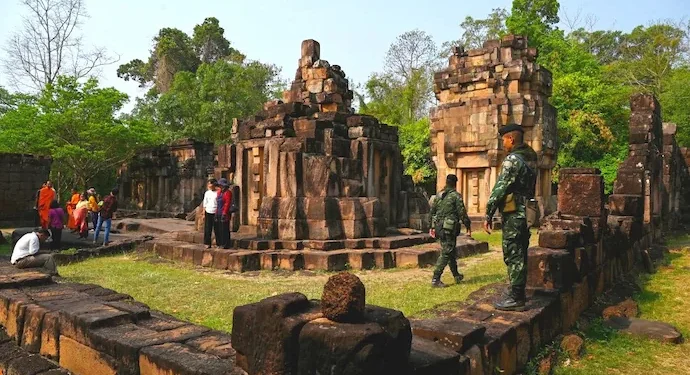Lagatar24 Desk
Phnom Penh: An 11th-century Hindu temple dedicated to Lord Shiva has become the flashpoint in an escalating military conflict between Thailand and Cambodia. The Prasat Ta Muen Thom temple, part of the Ta Muen Temple Complex near the Dangrek mountain range, lies at the heart of an ongoing border dispute rooted in colonial-era maps and regional pride.
Drones, Clashes and a Forgotten Temple
Tensions soared after Thai forces reported spotting Cambodian surveillance drones near the temple area on Wednesday. What followed was an alarming escalation—gunfire, rocket exchanges, and even F-16 airstrikes, plunging the region into a diplomatic and military standoff. Ambassadors were expelled, relations downgraded, and international attention returned to a forgotten cluster of Hindu temples nestled deep in contested forested terrain.
The focal point, Prasat Ta Muen Thom, also known as “Great Temple of the Grandfather Chicken,” was built during the reign of Khmer King Udayadityavarman II. Carved into natural rock, its sanctum houses a Shivling and Sanskrit inscriptions, symbolising the reach of ancient Indian civilisation into Southeast Asia.
Ancient Highway, Modern Conflict
The Ta Muen temple group, which includes Ta Muen Thom, Ta Muen Toch, and Prasat Ta Muen, was strategically located on a Khmer royal highway connecting Angkor in Cambodia to Phimai in Thailand. Once a thriving centre for Shaivite worship, the temples later transitioned to Buddhist use under King Jayavarman VII, aligning with the Khmer Empire’s religious evolution.
Architecturally, the temples showcase laterite and sandstone construction, detailed carvings of Hindu deities, and an unusually south-facing gopura—a distinct deviation from typical Khmer east-facing structures. While the temples bear deep religious and artistic ties to Indian Gupta and Pallava traditions, they have also become pawns in a geopolitical struggle.
Shaivism to Buddhism and Now to Battlelines
Initially dedicated to Hinduism, particularly Shaivism, the temple complex gradually embraced Mahayana Buddhism, featuring dharma salas and rest house chapels. However, their location on an undemarcated border—poorly defined by colonial French maps—has turned this cultural treasure into contested territory.
Cambodia claims the temples based on Khmer Empire boundaries, while Thailand asserts control due to modern administrative demarcation. The lack of clarity has turned these ruins into a battleground, both diplomatically and militarily.
India’s Cultural Imprint in Southeast Asia
The temples serve as enduring symbols of India’s historical influence in Southeast Asia. Trade, religion, and maritime networks from the 1st century brought Shaivism, Vaishnavism, and Indian political concepts like Devaraja to the Khmer elite. The result: temples with Indian iconography, Sanskrit texts, and divine kingship ideology built thousands of kilometres from the subcontinent.
These structures, largely forgotten and left in ruins, are now thrust into global focus—not for their spiritual legacy, but for their role in a 21st-century conflict. The war has turned sacred stones into strategic assets.









